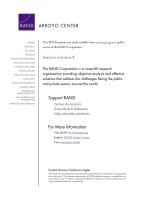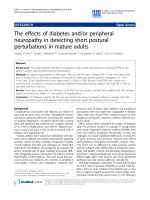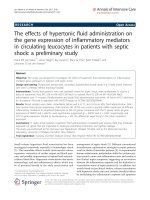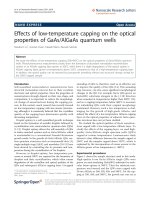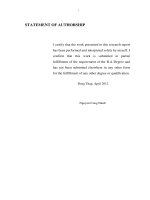Simulation study on the effects of operating temperature on cell electrodes in solid oxide fuel cells
Bạn đang xem bản rút gọn của tài liệu. Xem và tải ngay bản đầy đủ của tài liệu tại đây (1.18 MB, 8 trang )
JST: Engineering and Technology for Sustainable Development
Volume 32, Issue 3, July 2022, 017-024
Simulation Study on the Effects of Operating Temperature
on Cell Electrodes in Solid Oxide Fuel Cells
Xuan Vien Nguyen1*, An Quoc Hoang2, Hong Son Nguyen Le2
1
Department of Renewable Energy,
HCMC University of Technology and Education, Ho Chi Minh City, Viet Nam
2
Department of Thermal Engineering,
HCMC University of Technology and Education, Ho Chi Minh City, Viet Nam
Email:
*
Abstract
In this study, a three−dimensional numerical simulation on electrodes in solid oxide fuel cells (SOFCs) is
investigated in both regular cell and button cell configurations. The cell unit models with a regular cell with an
active area of 5cm × 5cm and with a button cell with an active area of 2.54 cm2 were conducted to investigate
the voltage distribution on cell electrodes in the solid oxide fuel cells (SOFCs). The performance characteristics
in SOFC cell unit are determined through a numerical simulation method by using a computational fluid
dynamic (CFD). The COMSOL Multiphysics software is used to investigate the model. The results show that
the cell voltage in both regular cell and button cell with operating temperatures of 650 and 700 °C were lower
than those at 750 °C. This means that when the operating temperature increases, the voltage and current
density on the solid oxide fuel cell electrodes increases, and the performance of the cell is also improved.
Keywords: Solid oxide fuel cell, numerical simulation, electrodes, voltage distribution, cell performance.
1. Introduction 1
The modeling and simulations are implemented
by using COMSOL Multiphysics. Simulations
indicated some promising features and performance
improvements of SOFC [6]. Temporal variation of the
output voltage was investigated [7]. A threedimensional model for a planar anode-supported
SOFC was developed, which includes governing
equations for momentum, heat, electron and ion
transport. The results showed that the strength of
stress of cell tends to be enlarged under fixed
constraint conditions [8].
Nowadays, along with the advancement in
science and technology, environmental and energysaving issues have also become the paramount concern
to improve people's quality of life. Increasing fossil
fuel depletion and excessively high environmental
pollution in the process of burning fuel and releasing
carbon dioxide (CO2) have been contributing to global
warming, leading to negative changes in nature.
Additionally, fossil fuels always have numerous
potential harmful substances causing human diseases.
Therefore, a wide range of solutions have been
conducted to tackle the above issue, in which finding
new sources of energy is considered an essential
requirement. In particular, renewable energy sources
and fuel cell energy sources are being strongly
developed because of many advantages in terms of
efficiency,
convenience,
and
environmental
friendliness [1-3].
In the present study, the voltage distribution on
cell electrodes in solid oxide fuel cells (SOFCs)
through three-dimensional numerical simulation
method is carried out using COMSOL Multiphysics.
The algorithm of this software is based on the finite
element method. The effects of different operating
with the input temperatures of 650, 700, and 750 ºC on
the cell performance are considered in this paper.
The model supported anodes of solid oxide
fuel cell (SOFC) is studied by using COMSOL
Multiphysics software. The results indicated the
position of maximum temperature distribution and
maximum temperature slope, as well as the model
performance parameters [4]. A numerical simulation
model was developed to visualize and better
understand various distributions such as gas
concentration and temperature in solid oxide fuel cells
(SOFCs) [5].
2. Methodology
2.1. Mathematic Equation
This model includes adjustment equations to
simulate the exchange behaviors, charge and
temperature of the species, as well as the constitutive
correlation to calculate the flow density. The anode
and cathode electrochemical reactions in the cell are
shown in following equations [9,10].
ISSN 2734-9381
/>Received: January 17, 2022; accepted: April 13, 2022
17
JST: Engineering and Technology for Sustainable Development
Volume 32, Issue 3, July 2022, 017-024
For anode:
2H 2 → 4H
+
+ 4e
c
F cH O
−1,5F
ia ,ct i0,a h 2 exp 0,5 η − 2 exp
=
η
ch 2,ref RT cH O ,ref RT
(1)
2
−
(6)
For cathode:
c
F
−0,5F (7)
ii ,ct i0,c exp 3,5 η − xo 2 t exp
=
η
(2)
RT
cO2 ,ref
RT
The energy equation can be described using the
where F is the Faraday's constant, R is the universal
conduction equation to obtain the temperature
gas constant, η is the overpotentials, ci and ci,ref
distribution in the cell [11].
represents the molar concentrations and reference
concentrations and xO2 is the molar fraction of oxygen.
(3)
A
eff
O2 + 4 H + + 4e − → 2 H 2 O
∇ ⋅ (−k
∇T ) = ST
V eff
Species conservation equation is written as:
Electrochemical reactions can be reasonably
assumed to occur at the electrode/electrolyte interface.
In the electrode, the Ohm’s law is used to treat the
transport of electronic charge and ionic charge,
respectively.
A
−∇ ⋅ (σ eeff ∇ϕe ) = Se
V eff
(4)
A
−∇ ⋅ (σ ieff ∇ϕ i ) = Si
V eff
(5)
In (3), (4), (5),
σ
eff
e
and
σ
eff
i
ω
∇ ⋅ ( ρωi u ) = ∇ ⋅ ( ρ i Dieff xi ) + R
i
xi
(8)
where Ŕi is mass production rate of species i, xi is
molar fraction of species i, ωi is mass fraction of
species i.
Mass conversion equation is written as:
∇ ⋅ ( ρ u ) =W
(9)
where W is mass source.
are the effective electron
Momentum conservation equation:
2
ρ uu
) = −ε∇p + ∇ ⋅ [ µ (∇u + ∇u T ) − µ∇u ] + ε FDa
∇⋅(
3
ε
conductivity and the ionic conductivity, respectively.
k eff is the effective thermal conductivity and includes
the thermal conductivity of pores and solid materials,
A
V is the specific surface area, which is the
eff
(10)
where ε is porosity, μ is dynamic viscosity of species,
FDa is Darcy’s friction force.
electrochemical reaction active area per unit volume,
ST is source term at pressure of 1atm and temperature
of 273 K.
2.2. Model Establishment and Mesh Generation
The model used to simulate the voltage
distribution on cell electrode is implemented with cell
having an active area of 5 cm ×5 cm for regular cell (as
shown in Fig. 1a) and a button cell with an active area
of 2.54 cm2 (as shown in Fig. 1b).
Butler-Volmer charge transfer kinetics describes
the charge transfer current density. The charge transfer
kinetics are shown in following equations [12]:
(a)
(b)
Fig. 1. The simulation model of a) regular cell b) button cell
18
JST: Engineering and Technology for Sustainable Development
Volume 32, Issue 3, July 2022, 017-024
The structure diagram of electrode layers in an
cell unit is shown in Fig. 2. After setting boundary
conditions and physical establishment for the model,
the model is meshed according to appropriate input
and output dimensions with the model shape in
accordance with individual dimensions of each
electrolyte layer and boundary layers of the model. In
regular cell model, the O2 flow rate of 400 ml/min on
the cathode surface and H2 flow rate of 200 ml/min
(3% water) on the anode surface are supplied. In button
cell model, the O2 flow rate of 150 ml/min on the
cathode surface and H2 flow rate of 100 ml/min (3%
water) on the anode surface are used.
Fig. 3 indicates the meshing of the SOFC cell unit
model. Since the model shape is not too complicated
with flat boundary edges, the meshing model selected
the linear elements as triangles with straight sides on
the model.
2.3. Boundary Conditions
The boundary conditions for the inlet gas
channels are defined as pressure with no viscous stress.
The gas mixture at the anode inlet is 97% H2 and 3%
H2O. On the cathode side, O2 is supplied into
the system. Zero flux is specified at the end of
the electrodes and electrolyte. The pressures are
fixed as atmospheric pressure (1atm). The boundary
conditions at the exits are limited as convective flux.
The temperature boundary condition at the inlets of
anode and cathode flow channels is set to the operating
temperature of 650 °C, 700 °C and 750 °C. The voltage
at the anode current collector is set to zero and to the
working cell voltage at the cathode current collector.
3. Results and Discussion
3.1. The distribution of Voltage on the Regular Cell
at the Different Temperatures
To investigate the influence of the temperature on
the performance of the SOFC, simulations were
conducted for this model with the O2 flow rate of
400ml/min on the cathode surface and H2 flow rate of
200ml/min on the anode surface. Figure 4 shows the
voltage difference on the regular cells at 650 ºC, 700 ºC
and 750 ºC. As shown in Fig. 4, the cell voltage with
operating temperatures of 650 ºC and 700 °C were
lower than those at 750 °C. This means that when the
input temperature increases, the voltage on the SOFC
surface increases and the performance of the fuel cell
is improved.
Fig. 2. Structure of the SOFC cell unit
Figure 5 shows the current density and voltage of
SOFC operating at different temperatures.
The simulation results show that the cell voltages
were 0.95 V, 0.98 V, and 1.05 V at 650 ºC, 700 ºC,
and 750 ºC, respectively. The maximum current
densities of the cell were found to be 350.3 mW/cm2,
456.05 mA/cm2, and 579.08 mW/cm2 with operating
temperatures of 650 ºC, 700 ºC, and 750 ºC,
respectively. From the comparison, it can be clearly
seen that the simulation result is suitable for the
theoretical values. When the operating temperature of
the cell rises, the current density and voltage of the cell
also increase, causing the performance of SOFC cells
to improve. This happens due to the increase in the
ionic conductivity in the electrolyte and
electrochemical reaction to the electrode at higher
temperatures.
a)
b)
Fig. 3. Mesh generation of a) regular cell; b) button cell
unit
19
JST: Engineering and Technology for Sustainable Development
Volume 32, Issue 3, July 2022, 017-024
(a)
(a)
(b)
(b)
(c)
(c)
Fig. 4. The distribution of voltage on the SOFC cells at
the temperatures of a) 650 ºC; b) 700 ºC; c) 750 ºC
Fig. 5. The voltage and current density on the SOFC
regular cells at the temperatures of a) 650 ºC;
b) 700 ºC; c) 750 ºC
3.2. The Distribution of Voltage on the Button Cell at
the Different Temperatures
Fig. 7 shows the current density and voltage of
button cell operating at different temperatures. The
simulation results show that the cell voltages were
0.92 V, 0.96 V and 1.02 V at 650, 700, and 750 ºC,
respectively. The maximum current densities of the
cell were found to be 830.7 mW/cm2, 932.6 mA/cm2,
and 1189.1 mW/cm2 with operating temperatures of
650, 700, and 750 ºC, respectively.
Figure 6 depicts the voltage distribution on
button cell electrode at operating temperatures of 650,
700, and 750 ºC. The results are similar with regular
cell (shown in Fig. 4). This means that the operating
temperature of the cell rises, the current density and
voltage of the cell also increase. In Fig. 4 and 6, the
highest voltage distributes in active area.
20
JST: Engineering and Technology for Sustainable Development
Volume 32, Issue 3, July 2022, 017-024
(a)
(a)
b)
(b)
c)
(c)
Fig. 7. The voltage and current density on the SOFC
button cells at the temperatures of a) 650 ºC; b) 700 ºC;
c) 750 ºC
Fig. 6. The distribution of voltage on the SOFC button
cells at the temperatures of a) 650 ºC; b) 700 ºC;
c) 750 ºC
21
JST: Engineering and Technology for Sustainable Development
Volume 32, Issue 3, July 2022, 017-024
3.3. The Experimental Performance of Regular Cell
at the Different Temperatures
Regular cells were fabricated from anode–
electrolyte tapes produced with sintering temperatures
of 1400 °C. Graphs of the power generation of a 5cm
× 5cm anode−supported single cell are shown in Fig.
8. The cell was operated using a hydrogen/3% water
mixture as fuel and air as an oxidant. The performance
of the anode−supported single cells was analyzed at
an operating temperature of 650 ºC, 700 ºC and 750
°C. With an operating temperature of 650 ºC,
open−circuit voltages (OCVs) of the single cell were
observed to be around 1.0 V. The maximum observed
power and current densities of the cell were found to
be 104.6 mW/cm2 and 395.84 mA/cm2, respectively.
The total output power was approximately 2.61 W, as
shown in Fig. 8a. Figure 8b shows the cell
performances with an operating temperature of 700 ºC.
As shown in the figure, the maximum power and
current densities of the cell were 135.6 mW/cm2 and
461.25 mA/cm2, respectively. The open−circuit
voltages (OCVs) of the cell were around 1.0 V, and the
total output power was approximately 3.39 W.
As shown in Fig. 8c, the open−circuit voltages (OCVs)
of the cell were around 1.01 V an operating
temperature of 750 ºC. The maximum power density
and current density of the cell were 178 mW/cm2 and
620.8 mA/cm2, respectively. The total output power
was 4.45 W. The results show that the regular cell
performances with operating temperatures of 650 and
700 °C were much lower than those with 750 °C. This
result is mainly attributed to the fact that a operating
temperature also affects the change in the activation of
the cell. This is similar to the simulation in Fig. 5.
Nevertheless, this investigation demonstrated the
feasibility of using an operating temperature in
SOFCs.
a)
b)
3.4. The Experimental Performance of Button Cell at
the Different Temperatures
Cells were fabricated from anode–electrolyte
tapes produced with a hot−pressing load of 3000 PSI
and sintering temperatures of 1400 °C. A cell with an
active reaction area of 2.54 cm2 was used as the
standard cell to test the power density. The OCV and
power density of the single cell at operating
temperatures of 650 ºC, 700 ºC and 750 °C are shown
in Fig. 9. The OCVs of cell were around 1.05 V, and
the maximum power densities of the cell were 245.7,
273.8, and 430.7 mW/cm2 at operating temperatures of
650 ºC, 700 ºC and 750 °C, respectively. The
maximum current densities of the cell were 785.4,
885.04, and 1252.4 mA/cm2, resulting in total output
powers of approximately 0.62, 0.71, and 1.09 W,
respectively. The results show that the cell
performances with operating temperatures of 650 and
700 °C were much lower than those at 750 °C. The cell
performances are quite similar to simulation results.
The optimal operating temperature of model is 750 °C.
c)
Fig. 8. The IV–IP curves of regular cell with operating
temperatures of a) 650 ºC; b) 700 ºC; c) 750 ºC
22
JST: Engineering and Technology for Sustainable Development
Volume 32, Issue 3, July 2022, 017-024
cell were 0.95 V, 0.98 V and 1.05 V at 650, 700, and
750 ºC, respectively. The cell voltages of button cell
were 0.92 V, 0.96 V and 1.02 V at 650, 700, and
750 ºC, respectively. The result shows when the
operating temperature increases, the voltage on the
SOFC surface increases and the performance of the
fuel cell is improved. This means that there is an
increase in the chemical reaction rate when the
operating temperature rises.
Acknowledgments
This research is funded by Vietnam National
Foundation for Science and Technology Development
(NAFOSTED) under grant number 107.03−2018.332.
The authors gratefully thank the HCMC University of
Technology and Education.
a)
References
[1]
L. Blum, L.G.J. de Haart, J. Malzbender, et al., Recent
results in Jülich solid oxide fuel cell technology
development, J. Power Sources, vol. 241 no. 1, Nov.
2013, pp. 477–485.
/>
[2]
AnduJar JM, Segura F., Fuel cells: History and
updating, A walk along two centuries, Renew and Sus
Energy Reviews, vol. 13, no. 9, Dec. 2009, pp. 2309–
2322.
/>
[3]
Mandeep Singh, DarioZappa, Elisabetta Comini.,
Solid oxide fuel cell: Decade of progress, future
perspectives and challenges, Int. J. Hydrogen Energy,
vol. 46, no. 54, Aug. 2021, pp. 27643−27674.
/>
[4]
Marko Nerat, Ðani Juricic, A comprehensive 3-D
modeling of a single planar solid oxide fuel cell, Int. J.
Hydrogen Energy, vol. 41, no. 5, Feb. 2016, pp.
3613−3627.
/>
[5]
K.Takino, et al., Simulation of SOFC performance
using a modified exchange current density for prereformed methane-based fuels, Int. J. Hydrogen
Energy, vol. 45, no. 11, Feb. 2020, pp. 6912−6925.
/>
[6]
Jawad Hussain, Rashid Ali, Majid Niaz Akhtar,
Modeling and simulation of planar SOFC to study the
electrochemical properties, Current Applied Physics,
vol. 20, no. 5, May 2020, pp. 660−672.
/>
[7]
Chaisantikulwat A, Diaz-Goano C, Meadows ES.,
Dynamic modelling and control of planar anode
supported solid oxide fuel cell, Comp. Chem. Eng.,
vol. 32, no. 10, Oct. 2008, pp. 2365−2381.
/>
[8]
MinXu, et al., Modeling of an anode supported solid
oxide fuel cell focusing on thermal stresses, Int. J.
Hydrogen Energy, vol. 41, no. 33, Sep. 2016, pp.
14927−14940.
/>
b)
c)
Fig. 9. The IV–IP curves of a button cell with operating
temperature of a) 650 ºC; b) 700 ºC; c) 750 ºC
4. Conclusion
In this work, the voltage distribution on regular
cell and button cell electrode in the solid oxide fuel cell
(SOFC) is investigated by using numerical simulation
method. The results show that the voltage distribution
with operating temperatures of 650 and 700 °C was
lower than those at 750 °C. The voltage of the regular
23
JST: Engineering and Technology for Sustainable Development
Volume 32, Issue 3, July 2022, 017-024
[9]
Young Jin Kim, Min Chul Lee, The influence of flow
direction variation on the performance of a single cell
for an anode-substrate flat-panel solid oxide fuel cell,
Int. J. Hydrogen Energy, vol. 45, no. 39, Aug. 2020,
pp. 20369−20381.
/>
[11] A. Su, Y.M. Ferng, C.B. Wang, C.H. Cheng,
Analytically investigating the characteristics of a
hightemperature unitized regenerative solid oxide fuel
cell, Int. J. Energy Research, vol. 37, no. 13, Oct. 2013,
pp. 1699–1708.
/>
[10] Congying Jiang, Yuchen Gu, Wanbing Guan, 3D
thermo-electro-chemo-mechanical coupled modeling
of solid oxide fuel cell with double-sided cathodes, Int.
J. Hydrogen Energy, vol. 45, no. 1, Jan. 2020, pp.
904−915.
/>
[12] A.N. Celik. Three-dimensional multiphysics model of
a planar solid oxide fuel cell using computational fluid
dynamics approach. Int. J. Hydrogen Energy vol. 43,
no. 42, Oct. 2018, pp. 19730−19748.
/>
24

